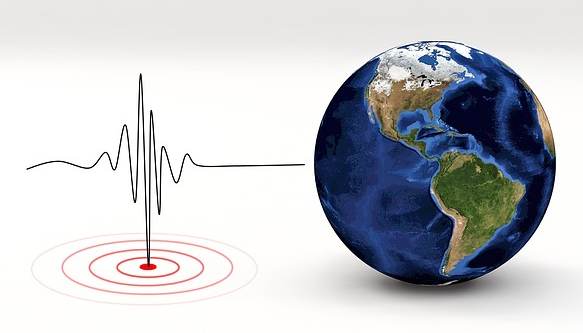Risk of large San Andreas quake up 3 to 5-fold since Ridgecrest: Temblor
The Ridgecrest, California sequence of earthquakes has increased the risk of a major San Andreas fault earthquake event occurring, according to newly published research.
 The paper published by Ross Stein of specialist seismic hazard catastrophe modelling company Temblor, Inc. and Shinji Toda of the International Research Institute of Disaster Science (IRIDeS) at Tohoku University in Japan, looks at the interplay and interactions between faults and how the Ridgecrest quake sequence occurred and what it might mean for California.
The paper published by Ross Stein of specialist seismic hazard catastrophe modelling company Temblor, Inc. and Shinji Toda of the International Research Institute of Disaster Science (IRIDeS) at Tohoku University in Japan, looks at the interplay and interactions between faults and how the Ridgecrest quake sequence occurred and what it might mean for California.
The work has obvious relevance for the insurance, reinsurance and insurance-linked securities (ILS) marketplace, as the researchers say they have identified an elevated level of risk of a major California earthquake occurring.
Given the unique nature of the research, this elevated risk may not be accounted for in other views of risk, in either third-party or internal catastrophe risk models. Which means, if the researchers are right, the risk may be being understated at this time.
The paper, titled Long- and Short-Term Stress Interaction of the 2019 Ridgecrest Sequence and Coulomb-Based Earthquake Forecast, explores so-called Coulomb stress transfer, which in seismic terms means the stress changes that can occur to surrounding material after local events that cause deformity within the geology of a region.
Its authors conclude:
Our forecast for the next 12 months yields a 2.3% chance of an Mw ≥ 7:5 Garlock fault rupture. If such a rupture occurred and reached within 45 km of the San Andreas, we calculate it would raise the probability of a San Andreas rupture on the Mojave section by a factor of 150. We therefore estimate the net chance of large San Andreas earthquake in the next 12 months to be 1.15%, or about three to five times its background probability.
The authors further explain that the learnings revealed in the paper “motivate our introduction of forecasts of future seismicity.”
It’s a technical study with the paper set to be published in the Bulletin of the Seismological Society of America. But given the potential ramifications we spoke with Temblor CEO and one of the people behind the paper Ross Stein.
“We calculate that Ridgecrest earthquakes brought the Garlock Fault significantly closer to failure, increasing its probability of a large rupture by a factor of 100 in the next year. The Garlock Fault connects the Ridgecrest Fault with the southern San Andreas. If the Garlock ruptured to the San Andreas, it would likely trigger a large earthquake on the San Andreas north of Los Angeles.
“Putting this together, the net chance of large San Andreas earthquake in the next 12 months is about 1.15%. While that may sound small, it is 3.5-5.0 times higher than its chances in the ‘UCERF3’ benchmark model for California issued by the USGS, and used by model vendors,” Stein told us.
Stein explained that earthquake events of this nature can cause enormous insurance and reinsurance market losses, of the magnitude that impacts would undoubtedly be felt across catastrophe bonds and ILS structures as well.
He explained, “A M 7.7 southern San Andreas event could exceed the Northridge toll of $40-60B losses. That’s because Munich Re estimates a great San Andreas event near L.A. would cause $300B in direct losses, and the take-up rate is about 20% (13% residential and 25% commercial).
“Greater Los Angeles and the ‘Inland Empire’ have the highest insured earthquake exposure in the U.S., making it a significant risk for those providing U.S. coverage. Not accounting for changes in earthquake stress and probability may severely underestimate the risk. Carriers, reinsurers, and cat bond holders could be carrying higher loss exceedance potentials than they realize, which could put their capital and financial rating at risk.”
The paper proposes its findings as a way to better understand the interactions between quake events, including for aftershocks and also to inform forecasts for future seismicity of specific regions.
How one earthquake fault could affect another, raising the potential for shocks along other fault lines, is an important area of research that can inform better catastrophe risk modelling and be factored into pricing of property insurance or reinsurance in quake prone regions.
Given how much capital from the ILS market is exposed to earthquake risks, in California and elsewhere around the globe, research like this seems worthy of this markets attention.
Of course, views will differ across scientists and catastrophe modelling firms, but this useful research provides an insight into how stress events can have knock-on effects on exposure profile that may not be all that well understood to-date.
Risk of large San Andreas quake up 3 to 5-fold since Ridgecrest: Temblor was published by: www.Artemis.bm
Our catastrophe bond deal directory
Sign up for our free weekly email newsletter here.
Original Article Posted at : https://www.artemis.bm/news/risk-of-large-san-andreas-quake-up-3-to-5-fold-since-ridgecrest-temblor/
